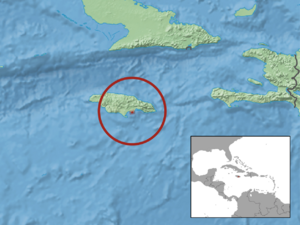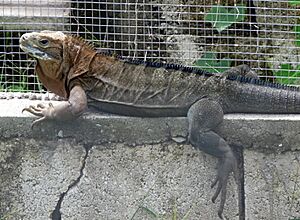Jamaican iguana facts for kids
Quick facts for kids Jamaican iguana |
|
|---|---|
 |
|
| Conservation status | |
| Scientific classification | |
| Genus: |
Cyclura
|
| Species: |
collei
|
 |
|
The Jamaican iguana (Cyclura collei), also known as Colley's iguana, is a large lizard. It belongs to the Iguanidae family, which includes many types of iguanas. This special iguana only lives in Jamaica. It is very endangered. People even thought it was gone forever between 1948 and 1990. It used to live all over Jamaica, including small islands like Great Goat Island and Little Goat Island. Today, you can only find it in the forests of the Hellshire Hills.
Contents
What's in a Name?
The scientific name, collei, honors someone named Colley. John Edward Gray first described this iguana in 1845. He called it "Colley's Iguana" but did not say who Colley was.
Appearance and Size
The Jamaican iguana is a big, heavy lizard. Its body is mostly green or bluish-green. It has darker olive-green areas on its shoulders. Three dark, wide V-shapes run from its neck to its tail. These V-shapes have dark olive-brown zigzag spots. The scales on its back crest are a brighter bluish-green.
Its body also has yellowish blotches that break into smaller spots. Wild iguanas, especially females digging nests, often look reddish-brown. This is because of the red soil in the Hellshire Hills where they live.
The Jamaican iguana is the second-largest land animal native to Jamaica. Only the Jamaican boa snake weighs more. Male iguanas can weigh over 2 kilograms (4.4 pounds). They can grow to about 42.8 centimeters (16.9 inches) long. Females are a bit smaller, reaching about 37.8 centimeters (14.9 inches) long.
Males also have large femoral pores on the underside of their thighs. These pores release special scents called pheromones. Females have smaller pores and their back crests are not as tall. This difference between males and females is called sexual dimorphism.
Where Do They Live?
Long ago, iguanas were common all over Jamaica. This was noted by Hans Sloane, a doctor and botanist who visited in 1688. The number of Jamaican iguanas dropped a lot in the late 1800s. This happened after the small Asian mongoose was brought to Jamaica. The mongoose was meant to control rats and snakes.
People thought the Jamaican iguana was extinct in 1948. A dead one was found in 1970. But in August 1990, a live adult male iguana was found. A hog hunter named Edwin Duffus and his dog chased it into a log in the Hellshire Hills. The iguana was taken to the Hope Zoo. Soon after, a small group of these iguanas was found living there.
Today, the Hellshire Hills is the only place in Jamaica where these iguanas live. They are found in two small groups of scattered individuals. They used to be all over the island. Now, they only live in the dry, rocky, limestone forests of St. Catherine. Before 1990, the last time a live iguana was seen was in 1940 on Goat Island.
What Do They Eat?
Like all Cyclura species, the Jamaican iguana mainly eats plants. They munch on leaves, flowers, and fruits from over 100 different plant types. They rarely eat insects or small creatures like snails. However, they might eat these by accident while eating leaves where the creatures live.
Protecting the Iguana
Why Are They Endangered?
As you know, the Jamaican iguana was thought to be extinct since 1948. After it was found again in 1990, a study showed there were only about 50 left. They were called the "rarest lizard in the world." The IUCN (International Union for Conservation of Nature) lists them as a Critically Endangered species. This means they are at a very high risk of disappearing forever.
What Caused Their Decline?
The main reason the Jamaican iguana almost disappeared was the small Asian mongoose (Urva auropunctata). These mongooses were brought in to control snakes. But they started eating young iguanas instead. This led to a special facility being built to help baby iguanas. There are also plans to remove the wild mongooses.
Today, the biggest danger to the iguanas is not the mongoose. It is the charcoal industry. People who make charcoal cut down hardwood trees in the Hellshire Hills. This is the main home for the iguanas. These charcoal burners have sometimes threatened the teams trying to protect the iguanas.
How Are They Being Saved?
A group of twelve zoos, including some from the USA, helped build a "Headstart Facility" at Hope Zoo. This facility is used to raise iguana eggs and hatchlings brought from the wild. In this safe place, the young iguanas grow until they are big enough to survive on their own. At this size, predators like the mongoose are no longer a threat. This process is called "headstarting".
The Headstart facility also checks the health of the iguanas before they are released. This helps scientists understand what is normal for the species. It also helps find any problems like parasites or diseases that could harm the population.
In August 2006, the number of Jamaican iguanas in zoos in the US doubled. This happened when 22 babies hatched at the Indianapolis Zoo. This was the first time these iguanas successfully bred and hatched outside of Jamaica.
In 2021, experts estimated there are now about 500–600 adult iguanas. This shows that there is a good chance for the species to recover.



